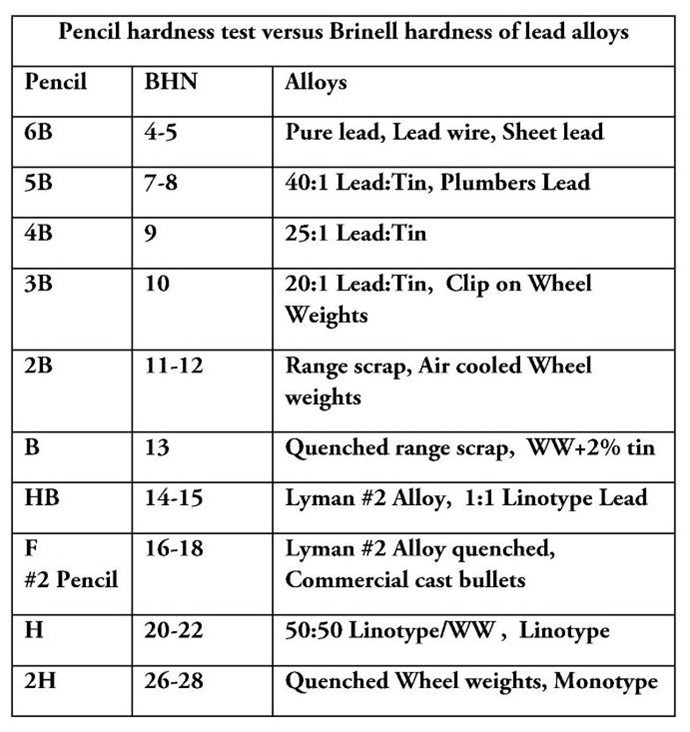THE PENCIL TEST FOR LEAD ALLOY HARDNESS
Ken Mollohan
The pencil industry manufactures what are called 'art pencils' for draftsmen, artists, etc. They are available as either conventional wood sheathed graphitic cores, or as a mechanical pencil for which you only buy the graphitic cores and insert them as desired.
The hardness of art pencils is controlled very strictly, and they are designated by a letter-number combination. The scale runs from at less than 6B (VERY soft) and gets slightly harder with each step up, going to 5B, 4B, 3B, 2B, B, HB, H, 2H, 3H, 4H, 5H, 6H, 7H, 9H, 10H, 11H and 12H that I know of. 6B is softer that most scrap lead, while 12H will cut into some grades of aluminum and copper, which are far harder than most lead alloys.
This provides 18 steps in hardness, but you won't need much more than about the range of 6B to about 2H. Oh yes, there ARE even softer and harder art pencils, but they're not often used, and can be pretty hard to find.
They are used industrially to measure the hardness of paints, among other things. I have a background in the paint industry, and have used the technique for my alloys for decades. It's really quick, simple, easy, and reproducible from one time to the next, and from one person to
the next.
To use them to measure hardness properly does take a certain technique, but it's easy to learn:
You prepare the pencil by peeling away the wood sheath (or simply advancing the replaceable core in the mechanical version) to leave a cylindrical graphitic core. It's best to do this with your fingernails to avoid scraping the core if you want to get the best (most consistent) results.
Now hold the pencil straight up and down as you smooth the tip on a bit of fine sandpaper. I usually use something like 360 to 400 grit. The objective is to form a perfectly square sharp wadcutter configuration on the end of the pencil core, so that you can reproduce the exact same cutting edge every time. Blow a puff of air on the tip or wipe it very gently with a bit of cotton to remove any loose graphite.
Now hold the pencil at a 45-degree angle to the surface of the lead, and push along the
length (the long axis) of the pencil. If the sharp edge of the core is harder than the lead, it will
dig in and scratch the surface. If the core is NOT harder than the lead, the sharp edge will crumble, and it will skid across the surface of the lead.
You should be aware of a couple of easily avoided problems that can mess up your results:
1. You need to move to a new spot on the lead for each test. Otherwise, the next pencil core could skid more easily on the surface, which is now lubricated with graphite from the previous test.
2. Likewise, the pencil should be rotated slightly for each test: Skidding across the
lead surface will blunt the sharp edge, and unless you rotate the pencil in your fingers to present a fresh cutting edge, the blunted edge will not cut in as well.
3. These graphite cores were not originally designed for this test, as I mentioned above. Mixing of the clays, graphite, etc. is not always perfect, and you may occasionally (!!) encounter a tiny pinpoint of grit that will give you a false indication. For this reason, you need to make several tests with the same pencil, rotating it for a fresh edge each time. You can easily get three or four tests from the same tip before it needs to be resharpened. If it gouges on one test, but slips on the others, assume the one gouge was due to a pinpoint hard speck, and rate it as equal to the majority results. It's not a real problem, just something to be aware of.
Hardness is rated as being equal to the hardest pencil that will NOT cut into the surface. For example, if a 'HB' pencil skids across the surface, but an 'H' pencil makes gouges, your alloy is 'HB' in hardness.
One of the nice things about this technique is the very small area needed to test. Once you have the knack, you can easily get meaningful results on loaded ammo, sprues, or most any surface that gives you a uniform surface about an eighth of an inch long for each pencil.
Hope you find this interesting and useful. Feel free to ask any questions that may occur
to you.





















